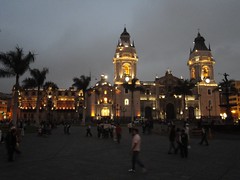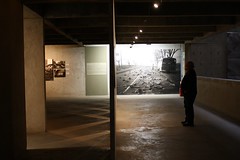Since my arrival four days ago, I have been catching up with the sights and sounds of Lima, which is everything I remembered, only better. On my first visit here a few years back, it was cold and grey—the humidity chilled me to the bone, the atmosphere was heavy, and ironically I remember being thankful I was only passing through such a gloomy place. Still, I did appreciate the charm of the old, sprawling buildings of Central Lima and their majestic timelessness.
This time around, I am staying in the posh neighbourhood of Miraflores, and to be honest I already feel quite at home. Of course, there are thousands of things I still don’t know (I have been told getting to the EPAF office is going to be a challenge—thankfully one of my co-workers is picking me up tomorrow for my first day!). What I mean is that I feel quite comfortable in my new surroundings. Here are a few things I just love about Lima: jogging on the malecón (a promenade overlooking the ocean shore), strangely exhilarating (and sometimes a little scary) taxi rides, not to mention the food (oh, the delicious food!). Yet, I can’t help but feel a tinge of guilt at choosing to spend my time in Peru in such an affluent neighbourhood; it is certainly not representative of the way the vast majority of Peruvians live.
Yesterday, I completed a mandatory visit to the Yuyanapaq: Para Recordar photo exhibit of the internal conflict at the Museo de la Nación. I won’t say too much about the exhibit as former fellows with EPAF have already blogged about it (you can read their posts here and here), but I do want to make a few general comments. I remember visiting a similar type of photo exhibit on the conflict in the former Yugoslavia while in Dubrovnik many years back. The exhibit had a profound impact on me, and to this day it is the first thing I think of when I recall my visit to the Balkans. I have always been fascinated by photography’s power to convey messages and emotions, particularly when the stories behind the photos are so horrific that words could never do them justice.
Upon arriving, I was disappointed by the very small number of people who were present. Is it from a lack of interest, I asked myself, or perhaps a lack of awareness about the exhibit? But then more and more people began arriving, until the place was busy with foreigners and Peruvians of all ages. I was even surprised by the number of children present; many Peruvians, it seems, understand the importance of remembering the unpleasant past and are intent to show their children the horrors of the war to make sure it never happens again. I left the exhibit even more convinced of the importance and relevance of the work of EPAF—but more on that in a future post. It is with much anticipation that I start work tomorrow!
Posted By Catherine Binet
Posted May 15th, 2011






92 Comments
Chelsea
May 20, 2011
Looks beautiful, looking forward to hearing more about the work you’re doing!